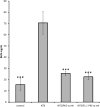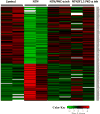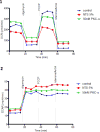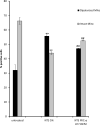Kidney-targeted inhibition of protein kinase C-α ameliorates nephrotoxic nephritis with restoration of mitochondrial dysfunction
- PMID: 29731111
- PMCID: PMC6084791
- DOI: 10.1016/j.kint.2018.01.032
Kidney-targeted inhibition of protein kinase C-α ameliorates nephrotoxic nephritis with restoration of mitochondrial dysfunction
Abstract
To investigate the role of protein kinase C-α (PKC-α) in glomerulonephritis, the capacity of PKC-α inhibition to reverse the course of established nephrotoxic nephritis (NTN) was evaluated. Nephritis was induced by a single injection of nephrotoxic serum and after its onset, a PKC-α inhibitor was administered either systemically or by targeted glomerular delivery. By day seven, all mice with NTN had severe nephritis, whereas mice that received PKC-α inhibitors in either form had minimal evidence of disease. To further understand the underlying mechanism, label-free shotgun proteomic analysis of the kidney cortexes were performed, using quantitative mass spectrometry. Ingenuity pathway analysis revealed 157 differentially expressed proteins and mitochondrial dysfunction as the most modulated pathway. Functional protein groups most affected by NTN were mitochondrial proteins associated with respiratory processes. These proteins were down-regulated in the mice with NTN, while their expression was restored with PKC-α inhibition. This suggests a role for proteins that regulate oxidative phosphorylation in recovery. In cultured glomerular endothelial cells, nephrotoxic serum caused a decrease in mitochondrial respiration and membrane potential, mitochondrial morphologic changes and an increase in glycolytic lactic acid production; all normalized by PKC-α inhibition. Thus, PKC-α has a critical role in NTN progression, and the results implicate mitochondrial processes through restoring oxidative phosphorylation, as an essential mechanism underlying recovery. Importantly, our study provides additional support for targeted therapy to glomeruli to reverse the course of progressive disease.
Keywords: PKC-α inhibition; glomerular endothelial cells; mitochondrial dysfunction; nephritis; proteomics; targeted delivery.
Copyright © 2018 International Society of Nephrology. Published by Elsevier Inc. All rights reserved.
Figures













Similar articles
-
ASK1 inhibitor treatment suppresses p38/JNK signalling with reduced kidney inflammation and fibrosis in rat crescentic glomerulonephritis.J Cell Mol Med. 2018 Sep;22(9):4522-4533. doi: 10.1111/jcmm.13705. Epub 2018 Jul 11. J Cell Mol Med. 2018. PMID: 29998485 Free PMC article.
-
Human anti-α3(IV)NC1 antibody drug conjugates target glomeruli to resolve nephritis.Am J Physiol Renal Physiol. 2015 Oct 15;309(8):F680-4. doi: 10.1152/ajprenal.00289.2015. Epub 2015 Aug 19. Am J Physiol Renal Physiol. 2015. PMID: 26290372 Free PMC article.
-
The TNF-derived TIP peptide activates the epithelial sodium channel and ameliorates experimental nephrotoxic serum nephritis.Kidney Int. 2019 Jun;95(6):1359-1372. doi: 10.1016/j.kint.2018.12.022. Epub 2019 Mar 21. Kidney Int. 2019. PMID: 30905471 Free PMC article.
-
An inhibitor of spleen tyrosine kinase suppresses experimental crescentic glomerulonephritis.Int J Immunopathol Pharmacol. 2018 Jan-Dec;32:2058738418783404. doi: 10.1177/2058738418783404. Int J Immunopathol Pharmacol. 2018. PMID: 29923438 Free PMC article.
-
Protein kinase Cα as a heart failure therapeutic target.J Mol Cell Cardiol. 2011 Oct;51(4):474-8. doi: 10.1016/j.yjmcc.2010.10.004. Epub 2010 Oct 16. J Mol Cell Cardiol. 2011. PMID: 20937286 Free PMC article. Review.
Cited by
-
Targeted Drug Delivery Systems for Kidney Diseases.Front Bioeng Biotechnol. 2021 May 28;9:683247. doi: 10.3389/fbioe.2021.683247. eCollection 2021. Front Bioeng Biotechnol. 2021. PMID: 34124026 Free PMC article. Review.
-
The Effects of Icariin on Enhancing Motor Recovery Through Attenuating Pro-inflammatory Factors and Oxidative Stress via Mitochondrial Apoptotic Pathway in the Mice Model of Spinal Cord Injury.Front Physiol. 2018 Nov 16;9:1617. doi: 10.3389/fphys.2018.01617. eCollection 2018. Front Physiol. 2018. PMID: 30505282 Free PMC article.
-
Cellular mechanism of action of forsythiaside for the treatment of diabetic kidney disease.Front Pharmacol. 2023 Jan 13;13:1096536. doi: 10.3389/fphar.2022.1096536. eCollection 2022. Front Pharmacol. 2023. PMID: 36712665 Free PMC article.
-
Feprazone Ameliorates TNF-α-Induced Loss of Aggrecan via Inhibition of the SOX-4/ADAMTS-5 Signaling Pathway.ACS Omega. 2021 Mar 12;6(11):7638-7645. doi: 10.1021/acsomega.0c06212. eCollection 2021 Mar 23. ACS Omega. 2021. PMID: 33778274 Free PMC article.
-
Novel Drug Delivery Technologies and Targets for Renal Disease.Hypertension. 2022 Sep;79(9):1937-1948. doi: 10.1161/HYPERTENSIONAHA.122.17944. Epub 2022 Jun 2. Hypertension. 2022. PMID: 35652363 Free PMC article. Review.
References
-
- Yung S, Zhang Q, Zhang CZ, Chan KW, Lui SL, Chan TM. Anti-DNA antibody induction of protein kinase C phosphorylation and fibronectin synthesis in human and murine lupus and the effect of mycophenolic acid. Arthritis and rheumatism. 2009;60(7):2071–2082. - PubMed
-
- Yung S, Zhang Q, Chau MK, Chan TM. Distinct effects of mycophenolate mofetil and cyclophosphamide on renal fibrosis in NZBWF1/J mice. Autoimmunity. 2015;48(7):471–487. - PubMed
-
- Kang N, Alexander G, Park JK, et al. Differential expression of protein kinase C isoforms in streptozotocin-induced diabetic rats. Kidney international. 1999;56(5):1737–1750. - PubMed
Publication types
MeSH terms
Substances
Grants and funding
LinkOut - more resources
Full Text Sources
Other Literature Sources
Research Materials

